- 1Research Institute of Petroleum Exploration and Development (RIPED), China National Petroleum Corporation (CNPC), Beijing, China
- 2Cores and Samples Center of Natural Resources, China Geological Survey, Beijing, China
- 3Key Laboratory of Basin Structure & Hydrocarbon Accumulation, China National Petroleum Corporation, Beijing, China
- 4PetroChina Hangzhou Research Institute of Geology, CNPC, Hangzhou, Zhejiang, China
- 5School of Geoscience, China University of Petroleum (East China), Qingdao, Shandong, China
Introduction: The genesis mechanism of cratonic strike-slip faults in the Sichuan basin is not yet fully resolved, largely due to the lack of comprehensive characterization of fault distribution, which constrains the understanding of the relationship between fault development and tectonic events.
Method: In this study, we supplement extensive three-dimensional seismic data from areas beyond central Sichuan to delineate fault distribution across the entire basin. By integrating these findings with regional tectonic processes, the genesis mechanisms of these faults are proposed.
Result: The results reveal that cratonic strike-slip faults are exclusively concentrated in central Sichuan and the Weiyuan area, with no such faults observed elsewhere in the basin. This spatial restriction suggests that their formation was governed by the unique tectonic evolution of central Sichuan.
Discussion: Furthermore, three lines of evidence prove that multi-stage uplifts played a pivotal role in fault development: (1) Faults of varying orientations exhibit distinct development periods, aligning with regional uplift phases; (2) Fault orientations correlate with the bending directions of strata induced by uplifts; and (3) Additional examples of analogous faults in Jurassic strata near the foreland front uplift further corroborate the link between fault orientation and strata bending caused by uplift processes. The central Sichuan region, characterized by superimposed multi-phase paleo-uplift evolution, thus serves as the focal zone for these faults. It is also inferred that the so-called “cratonic strike-slip” fault system in central Sichuan is not a genuine strike-slip system but rather a composite of normal faults with different directions and periods. The genesis of these normal faults is attributed to the tensile strain resulting from strata bending during uplift events. This study not only provides a more comprehensive characterization of fault distribution but also introduces a novel genetic model for these faults, which provides crucial data and new ideas for improving the theory of the fault system within the basins.
Introduction
Cratonic strike-slip faults occur within plates or sedimentary basins. This new structural phenomenon was discovered in the Sichuan Basin and has significant importance in structural research and oil and gas exploration (Yin et al., 2013; Su et al., 2021; Huang et al., 2022; Zhang et al., 2022; Fu et al., 2023; He et al., 2023; Tang et al., 2023; Lu et al., 2024). Based on the three-dimensional seismic data in the central Sichuan Basin, several studies have provided detailed deformation features of these faults, making significant progress (Ma et al., 2018; Guan et al., 2022a; 2022b; Jiao et al., 2022; Li C. et al., 2023; Liang et al., 2023; Ma et al., 2023; Wu G. et al., 2023). Current studies have a consistent understanding of the features of these faults in seismic sections. Most of the faults are highly dipped and some are almost vertical, with little normal fault displacement. The faults primarily extended from the bottom of the Sinian to the Lower–Middle Triassic. Several studies have suggested that the faults in the Middle–Lower Triassic and Jurassic strata are controlled by deformation related to these cratonic strike-slip faults (Su et al., 2023; Guan et al., 2024). Based on these studies, the distribution of cratonic strike-slip faults in the central Sichuan Basin, primarily striking NE, NEE, NWW, and EW, was described in detail through seismic interpretation (Figure 1). However, except in the central basin, the entire-basin-scale distribution of these faults has not been well studied. Only a few studies have been conducted in other areas, including the southern Sichuan structural belt, eastern Sichuan high-steeped structural belt, and western and northern Sichuan foreland depressions. Su et al. (2021) considered that strike-slip faults developed on the western slope of the Weiyuan structure and the central area of the Sichuan Basin and proposed that these faults did not develop in other areas according to typical seismic sections. Wu Y. et al. (2023) proposed that NW-striking strike-slip faults developed near the southeastern margin of the Kaijiang–Liangping Trough, located in north-central Sichuan Province. Two types of strike-slip faults are found in the Luzhou–Yunjin area of the southern Sichuan Basin; however, these faults show characteristics distinct from those in the central Sichuan basin (Tian et al., 2024a). One is a single high-steep strike-slip fault under the Cambrian detachment layer and the other is a complex fault system consisting of EW-, NS-, and NE-striking faults between the Gaotai Formation and the Triassic strata. NNW-striking high-dipped faults are also found in the eastern Sichuan high-steeped structural belt (Li et al., 2024), however, these faults are more closely related to the anticline above.
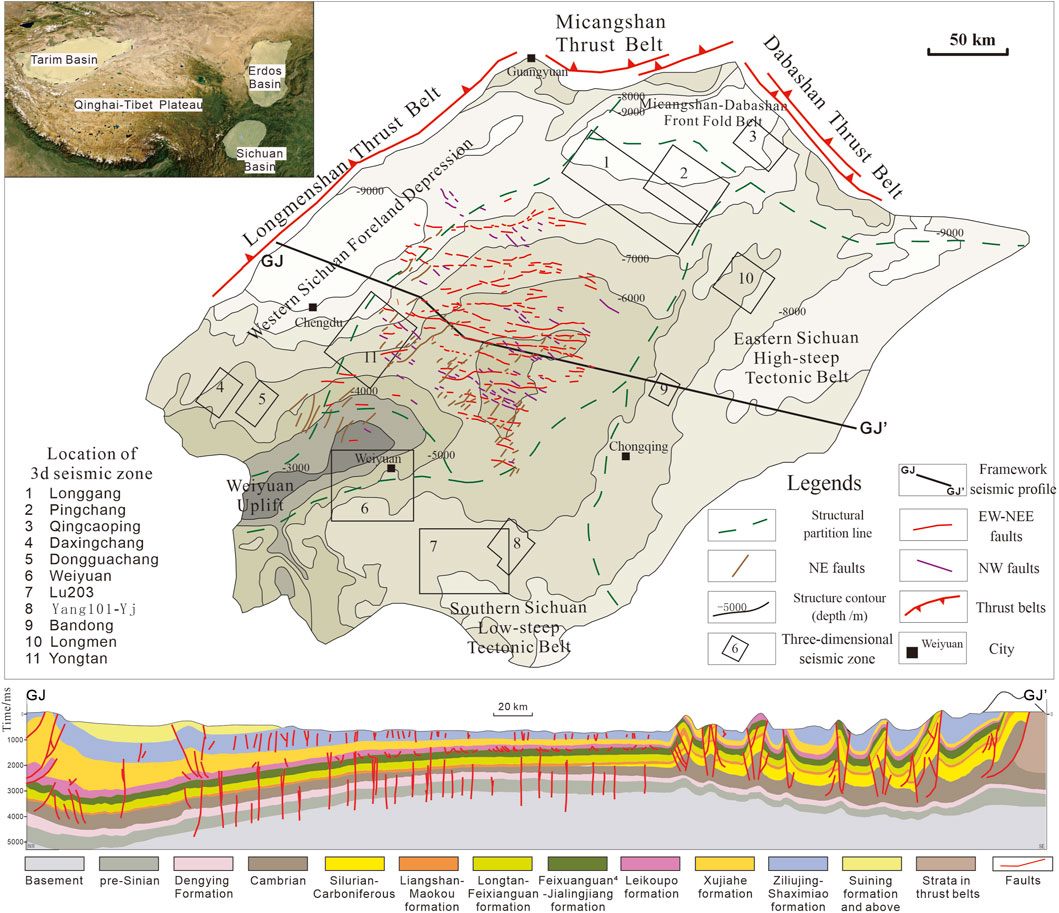
Figure 1. Superimposed map of strike-slip fault distribution and current structure of the bottom of the Cambrian in the Sichuan Basin and locations of three-dimensional seismic zones.
The lack of understanding of cratonic strike-slip faults in other areas of the basin restricts our understanding of the overall framework of the fault system and the rationality of the existing genesis mechanism. Most studies have proposed a multistage evolution controlled by pre-existing faults and subsequent tectonic events (Jiao et al., 2022; Guan et al., 2022a; 2022b; Fu et al., 2023; Liang et al., 2023; Ma et al., 2023; Lu et al., 2024). It is suggested that EW-striking faults developed during the Sinian Tongwan movement by adjusting the faults related to the formation of the Deyang-Anyue Rift, and new faults developed along the existing EW faults during the subsequent Caledonian (Ordovician to Early Devonian), Indosinian (middle-late Triassic) and Yanshanian-Himalayan (late Jurassic-Early Cretaceous and Cenozoic) orogenies. Pure and simple shear modes related to compressional deformation caused by thrust belts have been proposed (Huang et al., 2022; 2025). It has also been suggested that faults formed under a transtensional stress field, according to fault structural analysis and physical analog modeling (Su et al., 2021). These understandings regard the development of cratonic strike-slip faults as a result of a uniform stress field over the entire basin range. Therefore, it is necessary to establish the distribution law and structural characteristics of strike-slip faults in the entire basin to implement a genesis mechanism. If there is a particularity in the distribution range or a significant change in the fracture structure, this may become the key to solving the genesis mechanism problem.
In view of the above problems, this study uses multi-block three-dimensional seismic data from outside the central Sichuan Basin to explain and analyze the distribution characteristics of high-steep strike-slip faults. Its development was limited to the central region of the basin and Weiyuan area. This is considered to be controlled by the special structural conditions in the central region. Based on this, a new interpretation scheme for the genesis mechanism is proposed that better explains the characteristics of the diffuse distribution, multi-period, and multi-direction of strike-slip faults in the Sichuan Basin, which differ from the traditional strike-slip mode.
Data and method
Based on 11 areas with three-dimensional seismic data, the distribution and features of cratonic strike-slip faults were identified in different structural units. Two standards were followed to avoid incorrect identification. First, considering the typical characteristics of the strike-slip fault in central Sichuan as the standard, the faults should have evident event-axis dislocations that can be identified in coherent body slices. Second, the chosen study areas should be far from high-steep structures or gypsum-salt rock distribution areas because of their presence may affect the reliability of the seismic event horizons in the underlying strata. Considering that the cratonic strike-slip faults in the Sichuan Basin have a dispersed and even distribution, areas with a stable structure and good imaging quality were selected for identification, which did not affect the identification of whether the faults existed.
Coherence slices along layers are a critical technique in 3D seismic data processing for fault interpretation. Their core principle lies in identifying stratigraphic discontinuities by calculating the coherence between seismic traces (Bahorich and Farmer, 1995; Tingdahl and Rooij, 2005; Wu, 2017). This method enables rapid acquisition of the distribution and orientation of faults across different horizons within a 3D seismic zone. Subsequently, seismic profiles can be selected based on fault orientations to analyze fault characteristics and genesis mechanisms.
Geological setting
The Sichuan Basin was divided into five units: a low-gentle tectonic belt in the central basin, a western Sichuan foreland depression in front of the Longmenshan thrust belt, a southern Sichuan low-steep tectonic belt, an eastern Sichuan high-steep tectonic belt, and a northern Sichuan foreland depression in front of the Micangshan–Dabashan thrust belt (Figure 1). The Longmenshan thrust belt at the western margin of the basin began to develop during the Late Triassic and was uplifted violently again during the Cenozoic, which controlled the formation of the western Sichuan foreland depression (Jia et al., 2003; Chen et al., 2008). The northern foreland depression and fold belt were controlled by the evolution of the Micangshan–Dabashan thrust belt. Previous studies on deformation time have provided two understandings of the Yanshanian–Cenozoic and Indosinian–Yanshanian–Cenozoic three-stage deformations (Wang et al., 2006; Zhang, 2009; Xiao et al., 2011). The fold-thrust belt in eastern Sichuan was primarily formed during the Late Jurassic–Early Cretaceous of the Yanshan period and uplifted again during the Cenozoic Himalayan period (Mei et al., 2010; Wang et al., 2010; Zhang et al., 2012). The southern Sichuan low-steep tectonic belt was formed after the Early Cretaceous, and the apatite fission track indicates that the anticlines mostly formed rapidly during the Early Cenozoic.
Results
North-central sichuan
North-central Sichuan is located between the central Sichuan area and the Dabashan foreland depression in northern Sichuan and is adjacent to the high-steep fold belts in eastern Sichuan. As shown in the coherence slices (Figures 2a–c), faults with two directions, NNE and almost N-S striking, developed in the Sinian–Paleozoic strata in the Longgang and Pingchang areas (locations see one and two in Figure 1), which are closer to the central Sichuan Basin. Typical thrust faults occur in both directions (Figure 2d), and their directions are consistent with those of the high-steep fold belts in eastern Sichuan, indicating that these faults formed as a result of compressive stress in the east (Figure 2d). In addition to the NNE-striking thrust faults, another group of NW-striking thrust faults developed in the Qingcaoping area to the north (Figure 2c, location see three in Figure 1). The NW-striking faults were controlled by the thrust deformation of the Dabashan thrust belt. It should be noted that no high-steep strike-slip faults have developed in any direction in these areas.
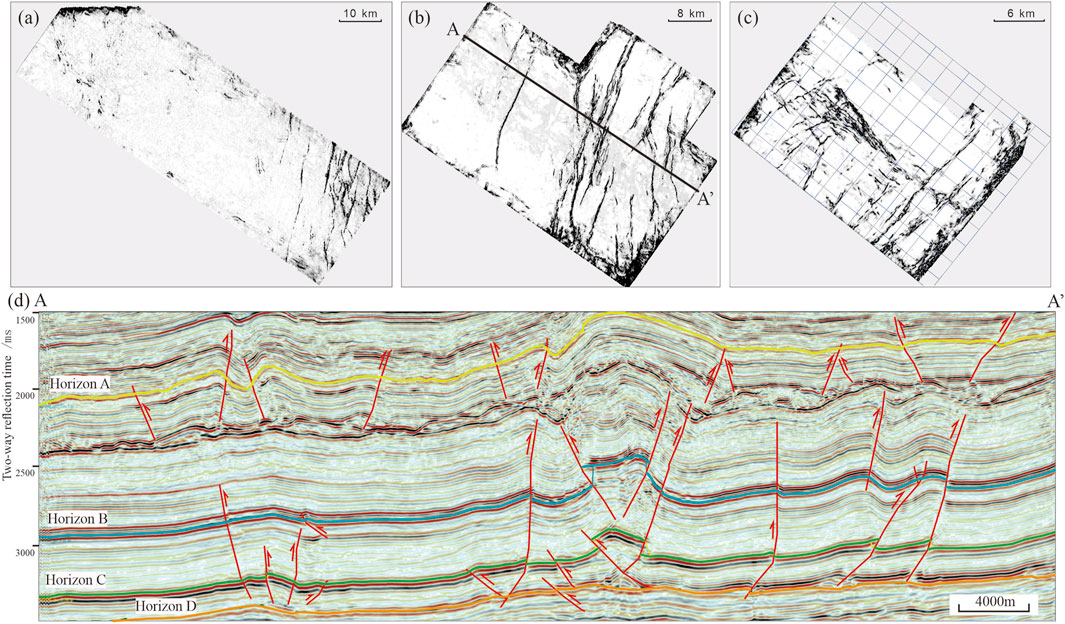
Figure 2. (a) Coherent slice of the bottom of the Ordovician Wufeng Formation in the Longgang three-dimensional seismic zone; (b) Coherent slice of the bottom of the Permian Longtan Formation in the Pingchang three-dimensional seismic zone; (c) Coherent slice of the bottom of the Permian Longtan Formation in the Qingcaoping three-dimensional seismic zone; (d) Fault interpretation result in the Pingchang three-dimensional seismic zone. Horizon A Bottom of Triassic Xujiahe Formation; Horizon B Bottom of Permian Longtan Formation; Horizon C Bottom of Ordovician Wufeng Formation; Horizon D Bottom of Cambrian Gaotai Formation.
Western Sichuan foreland depression
The Daxingchang and Dongguachang areas shown in Figure 3 are located in the southern section of the western Sichuan foreland depression (locations see four and five in Figure 1). The deformation was primarily controlled by the Longmenshan thrust belt to the west. Faults in two directions primarily developed in the Daxingchang area (Figure 3a), including NNE-trending faults represented by F1a–c and NE-trending faults represented by F2a–b. As shown in Figure 3c, these are thrust faults (Figure 3c). NNE-striking thrust faults are dominant in the Dongguanchang area, and we identified only one short NWW-striking normal fault. Similar to north-central Sichuan, we found no cratonic strike-slip faults in the central Sichuan Basin. Some other studies, through the analysis of the scale of fractures, have also found that reverse faults are mainly developed in the Western Sichuan foreland depression (Li et al., 2019).
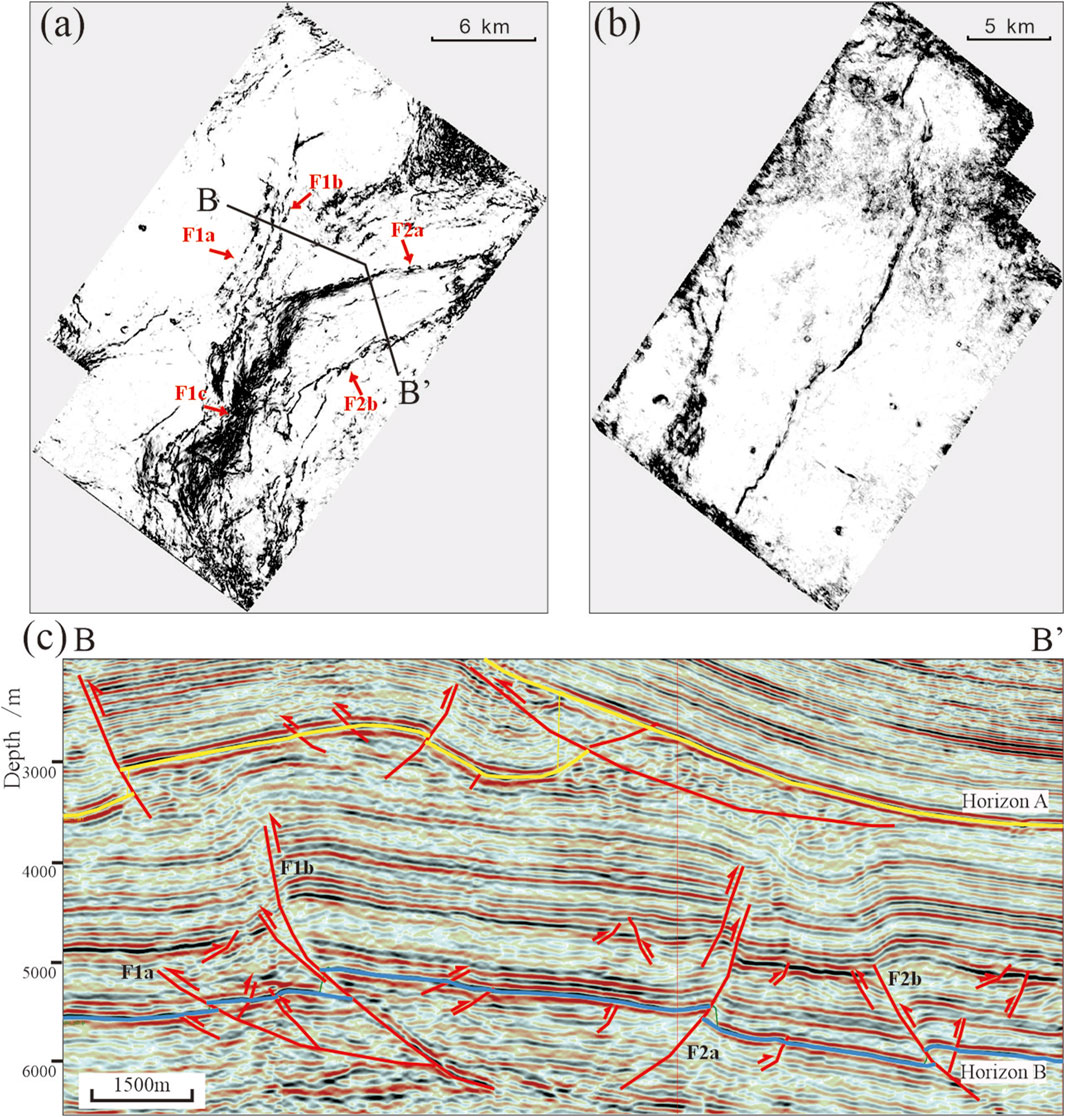
Figure 3. (a) Coherent slice of the bottom of the Permian Longtan Formation in the Daxingchang three-dimensional seismic zone; (b) Coherent slice of the bottom of the Cambrian Qiongzhusi Formation in the Dongguachang three-dimensional seismic zone; (c) Fault interpretation result in the Daxingchang three-dimensional seismic zone. Horizon A Bottom of Triassic Xujiahe Formation; Horizon B Bottom of Permian Longtan Formation.
Weiyuan area
The three-dimensional seismic zone is located on the southern slope of the Weiyuan structure (location six in Figure 1), on which three types of faults have developed. One is an almost EW-striking, high-steep strike-slip fault (F1 in Figure 4d); however, only one fault was identified. The second type comprises thrust faults controlled by thrust belts in various directions, including NE-striking thrust faults controlled by the Longmenshan thrust belt in the west (F2a–b in Figure 4a), NW-striking thrust faults controlled by the Cenozoic thrust belt in the west-southern margin of the Sichuan basin (F3a–c in Figures 4a,d), and NE-striking thrust faults controlled by the decollement thrust deformation of cap rock in southern Sichuan (F5 in Figures 4b,d). The last type comprises NWW-striking normal faults (F4a–b in Figures 4b,d,f). These NWW-striking faults have features similar to those in central Sichuan, with short extensions, high steepness, and little normal fault displacement. As shown in Figure 4b, three left-step en echelon faults may have developed on the southern side of the F4a fault, reflecting a dextral shear process under extensional conditions.
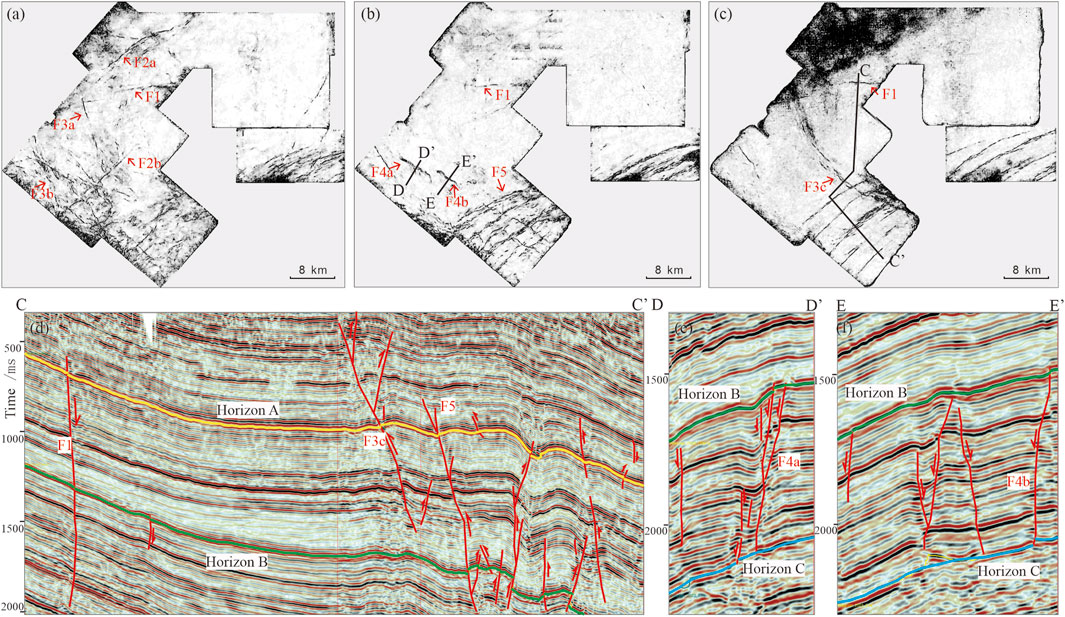
Figure 4. (a) Coherent slice of the bottom of the Cambrian Qiongzhusi Formation in the Weiyuan three-dimensional seismic zone; (b) Coherent slice of the bottom of the Ordovician Wufeng Formation in the Weiyuan three-dimensional seismic zone; (c) Coherent slice of the bottom of the Permian Longtan Formation in the Weiyuan three-dimensional seismic zone; (d) Fault interpretation result of seismic line C-C’; (e) Typical transtensional fault in seismic line D-D’; and (f) Typical transtensional fault in seismic line E-E’. Horizon A Bottom of Triassic Xujiahe Formation; Horizon B Bottom of Ordovician Wufeng Formation; Horizon C Bottom of Cambrian Qiongzhusi Formation.
Southern sichuan low-steep tectonic belt
The Luzhou area is located in the central region of the southern Sichuan low-steep tectonic belt (location seven and eight in Figure 1). Multiple rows of NNE-striking anticlines developed in the Lu203 three-dimensional seismic zone and open synclines lie between the anticlines. Three groups of faults were identified in the Ordovician Wufeng Formation: NEE-striking faults represented by F1a–c, NS-striking faults represented by F2a–b, and NE-striking faults represented by F3a–b (Figures 5a,d). According to the features of these faults in the seismic section (Figure 5d), all three groups are thrust faults that developed from the Cambrian detachment layer. The faults in the Cambrian Qiongzhusi Formation are consistent with those in the Ordovician Wufeng Formation and have almost the same position and direction as the overlying anticlines. We consider this to be the result of the influence of the overlying structures on seismic quality. This is similar to the Yang101–Yunjin three-dimensional seismic zone in the north, where thrust faults in various directions have developed (Figure 5c). As discussed above, thrust faults were dominant in the southern Sichuan Basin, and no cratonic strike-slip faults were found. Other studies have also found that reverse faults are mainly developed in southern Sichuan basin according to the analysis of fractures (Li et al., 2022; Li J. et al., 2023).
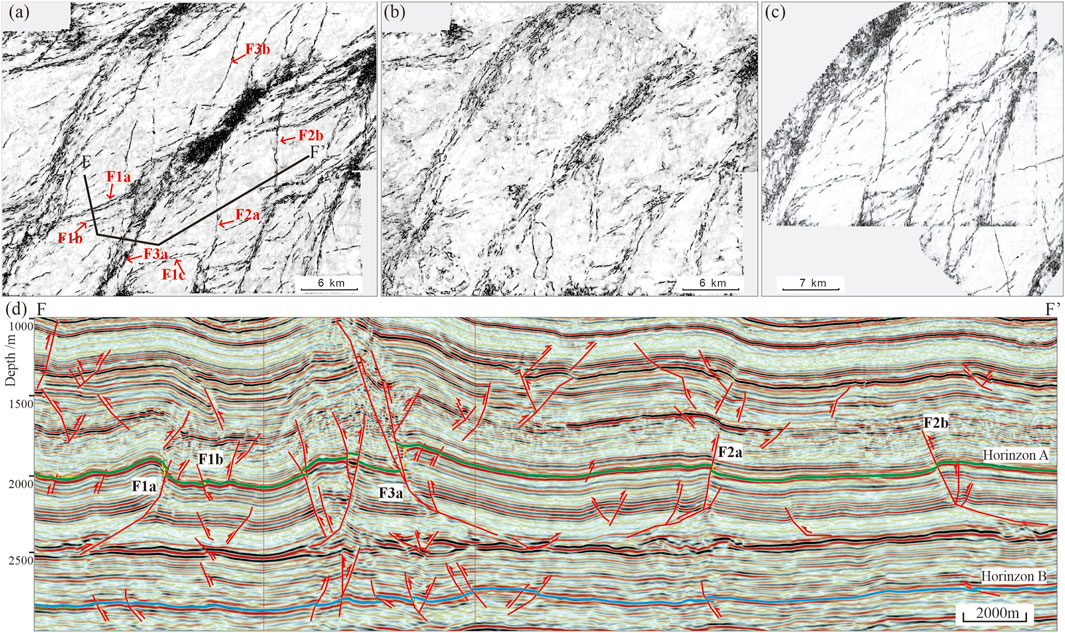
Figure 5. (a) Coherent slice of the bottom of the Ordovician Wufeng Formation in the Lu203 three-dimensional seismic zone; (b) Coherent slice of the bottom of the Cambrian Qiongzhusi Formation in the Lu203 three-dimensional seismic zone; (c) Coherent slice of the bottom of the Permian Longtan Formation in the Yang101-Yj three-dimensional seismic zone; (d) Fault interpretation result in the Lu203 three-dimensional seismic zone. Horizon A Bottom of Ordovician Wufeng Formation; Horizon B Bottom of Cambrian Qiongzhusi Formation.
Eastern sichuan high-steep tectonic belt
A typical Jura-type fold developed in eastern Sichuan, consisting of multiple rows of banded NNE-striking folds with narrow anticlines and wide synclines. The Bandong (Figure 6a, location nine in Figure 1) and Longmen three-dimensional seismic zones (Figure 6c, location 10 in Figure 1) are located separately in the southern and northern region of eastern Sichuan. Two groups of faults developed in the Ordovician Wufeng Formation in the Bandong area (Figure 6a), including NE-striking faults (F2) with greater length and NWW-striking faults (F1, and F3) with shorter lengths. According to the interpretation results (Figure 6d), both groups were thrust faults. This is similar to the Longmen area in the north, where NE- and NNW-striking thrust faults have developed. As discussed for the other areas above, we found no evidence for the development of cratonic strike-slip faults with features similar to those in central Sichuan.
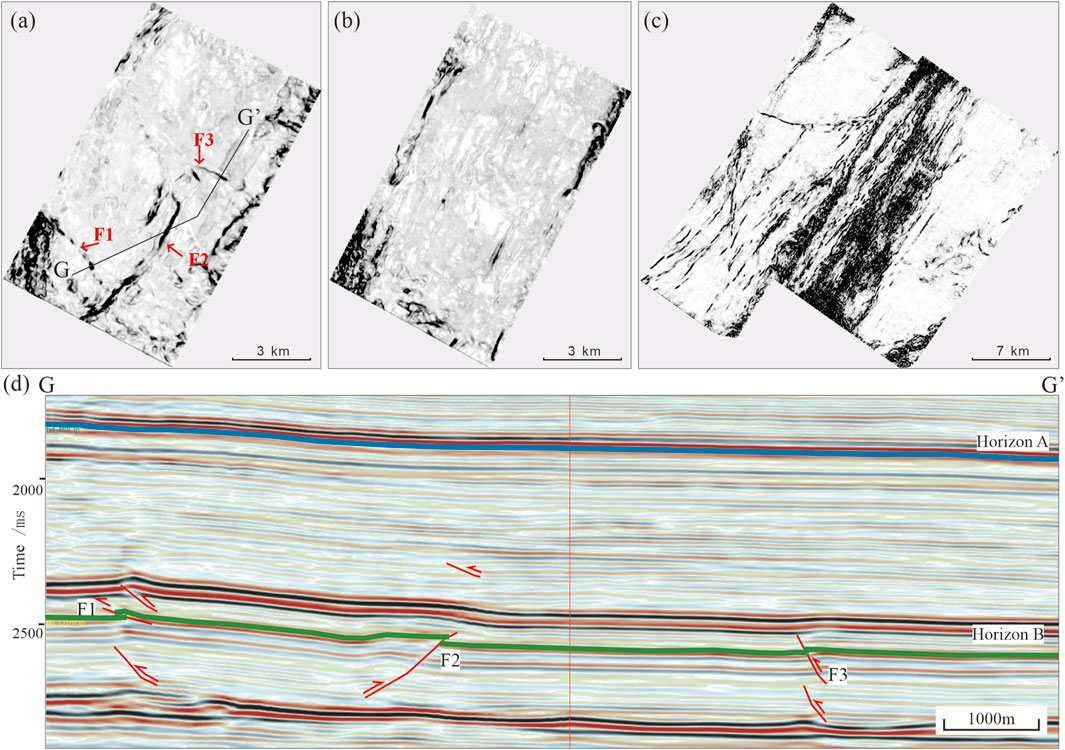
Figure 6. (a) Coherent slice of the bottom of the Ordovician Meitan Formation in the Bandong three-dimensional seismic zone; (b) Coherent slice of the bottom of the Permian Longtan Formation in the Bandong three-dimensional seismic zone; (c) Coherent slice of the bottom of the Ordovician Wufeng Formation in the Longmen three-dimensional seismic zone; (d) Fault interpretation result in the Bandong three-dimensional seismic zone. Horizon A Bottom of Permian Longtan Formation; Horizon B Bottom of Ordovician Wufeng Formation.
Discussions
Relationship between limited distribution and local tectonic evolution
As discussed above, cratonic strike-slip faults are found solely in the Weiyuan area and central Sichuan Basin, and no evidence of strike-slip fault development is found in other areas; that is, the distribution of these faults is limited rather than widespread across the entire basin. We propose that a distinctive tectonic evolutionary process may be the key controlling factor for cratonic strike-slip faults in the central Sichuan Basin for two reasons.
First, a uniform stress field or tectonic movement in the entire basin rarely forms a fault system with such a limited distribution. For example, previous studies have attempted to explain these faults using simple and pure shear modes under stress from plate boundaries; however, they cannot explain why faults occur solely in the center of the basin unless pre-existing structures are found and proven to change the uniform stress field. The tectonic movements in the Sichuan Basin can be considered the genesis of cratonic strike-slip faults only if they result in different deformations between the central Sichuan Basin and other regions. Taking the Sinian Tongwan movement as an example, it resulted in the uplift of the Sichuan Basin and development of the Deyang–Anyue Rift, which runs through the entire basin in a north-south direction. The coverage of the basin uplift and the Deyang–Anyue Rift is much greater than that of central Sichuan; therefore, it is difficult to explain the limited distribution of these faults.
Second, the central Sichuan area has a unique tectonic evolutionary and geological structure that differs from those of other areas and can form a fault system with multiple stages and directions. A unique feature of central Sichuan is its stable structural environment since the Triassic Indosinian movement. As a result of continuous compression during the Indosinian–Yanshanian–Himalayan movements, foreland depressions occurred in the western and northern Sichuan Basin, and complex fold belts developed in southern and eastern Sichuan; however, the central Sichuan area remained relatively stable. Therefore, previous studies suggest that the formation of strike-slip faults occurred later than the emergence of these tectonic units (Su et al., 2021), that is, during the Himalayan period. However, this does not adequately explain the diversity of the fault directions. An additional unique feature is the multi-stage uplift in the central Sichuan area from the Caledonian to the Himalayan period. During the Caledonian movement, the Leshan–Longnvsi paleo-uplift developed and the central Sichuan–Weiyuan area was located in the slope region. During the Indosinian movement, relative subsidence occurred in the western and northern Sichuan foreland depressions, causing relative uplift in the central Sichuan area. During the Yanshanian–Himalayan movements, as a result of the reactivation of the Longmenshan and Micangshan–Dabashan thrust belts, the foreland depressions continued to subside, and the central Sichuan area continued to uplift. This multistage upliftment process created a central Sichuan area that differs from the other areas, which explains the limited distribution of these faults. However, the uplifts developed during different periods and under compression from different directions, which could explain the diversity of fault directions and periods. Considering that most of the cratonic strike-slip faults in the central Sichuan area are transtensional faults (Li et al., 2018; Ma et al., 2018; Su et al., 2021) and tensile strain occurs during the upliftment and folding process, it is inferred that multistage uplifts may be the genesis of the faults in the central Sichuan Basin.
Relationship between fault development and multi-stage uplifts
This study provides three aspects of evidence to prove the influence of multistage uplifts on fault development: the consistency of development time between faults and uplifts, the directional correlation between faults and uplifts, an example of similar faults near another uplift.
Fault periods and multi-stage uplifts
The cratonic strike-slip faults in the central Sichuan area consist of three groups of faults in different directions (Figure 1). These groups of faults have different development periods, which are consistent with the uplift development periods. Taking the Yongtan three-dimensional seismic zone as an example (Figure 8, location 11 in Figure 1), two groups of faults primarily developed. One is a NW-striking fault, which is very steep, extends to the bottom of the Permian, and has almost the same minimal displacement in both the upper and lower regions, indicating that a normal fault formed during one period (Figures 8a,c). The fault displacement disappeared below the bottom of the Permian, and the strata thickness and seismic facies showed clear changes on the hanging walls and footwalls (Figure 8c). It is inferred that these normal faults developed and the subsidence region was filled before the Permian. Associated with tectonic evolution, these NW-striking faults resulted from the Ordovician Caledonian movement when the Leshan–Longnvsi paleo-uplift developed in the west of the Sichuan Basin (Liu et al., 2021; 2024). Caledonian NW-striking faults were also found in the Weiyuan area (Figures 4e, f). These faults extend to the bottom of the Ordovician Wufeng Formation, resulting in subsidence of the hanging wall strata. As shown by the arrow position, an extra seismic event was identified and regarded as filled strata, indicating the Caledonian development period. The other group is a NE-striking fault (Figures 8b, d), extending from the Cambrian to the Triassic strata. As there is no clear thickening and filling of the strata, the development time can be limited to after the early Indosinian period. During the Indosinian period, the Longmenshan thrust belt began to develop and caused the formation of the western Sichuan foreland depression and relative uplift in the central Sichuan area (Yong et al., 2003; Yan et al., 2011; Zhou et al., 2023). Except for the consistent development period, the direction of these NE-striking faults was parallel to that of the Longmenshan thrust belt.
Fault directions and multi-stage uplifts
According to the example in the Yongtan area, faults in different directions have different development periods related to the evolution of paleo-uplifts, and the fault direction may correspond to the direction of the thrust belt. We attempted to analyze the correlation between the fault distribution and paleotectonic morphology of each period by superimposing them. As shown in Figure 7a, three groups of faults developed in central Sichuan, including NW-, NE-, and EW-NEE-striking faults. As discussed above, the NW-striking faults developed during the Caledonian movement, and the fault direction was parallel to the striking strata on the northern slope of the paleo-uplift (Figure 7b). NE-striking faults began to occur during the Indosinian period. As a result of compression from the Longmenshan thrust belt, a northeastward uplift formed in the basin, which is consistent with the direction of the faults during that period (Figure 7c). However, we propose that the development of NE-striking faults may have lasted until the Himalayan period because the compression from the northwest was reactivated in the Yanshanian–Himalayan period, and the foreland depression continued to subside. EW-NEE-striking faults were expected to develop as a result of the relative uplift during the Yanshanian–Himalayan period. During that time, the Longmenshan, Micangshan, and Dabashan thrust belts were reactivated, causing further subsidence of the foreland depressions in the western and northern Sichuan Basins. In central-north Sichuan, the impact of the Micangshan thrust belt was the most significant, and the strata in the slope area near central Sichuan were further bent and finally distributed in the EW-NEE-striking direction, which is parallel to that of the Micangshan thrust belt. As shown in Figure 7d, the EW-NEE-striking faults were parallel to the nearby strata. Therefore, based on the consistency of their direction, we propose that the development of faults is related to multistage uplifts. The development sequence of the three fault groups is suggested to be associated with that of the uplifts. The NW-striking faults initially occurred during the Caledonian period. Subsequently, the NE-striking fault began to form during the Indosinian period. The EW-NEE-striking faults finally developed during the Yanshanian–Himalayan period.
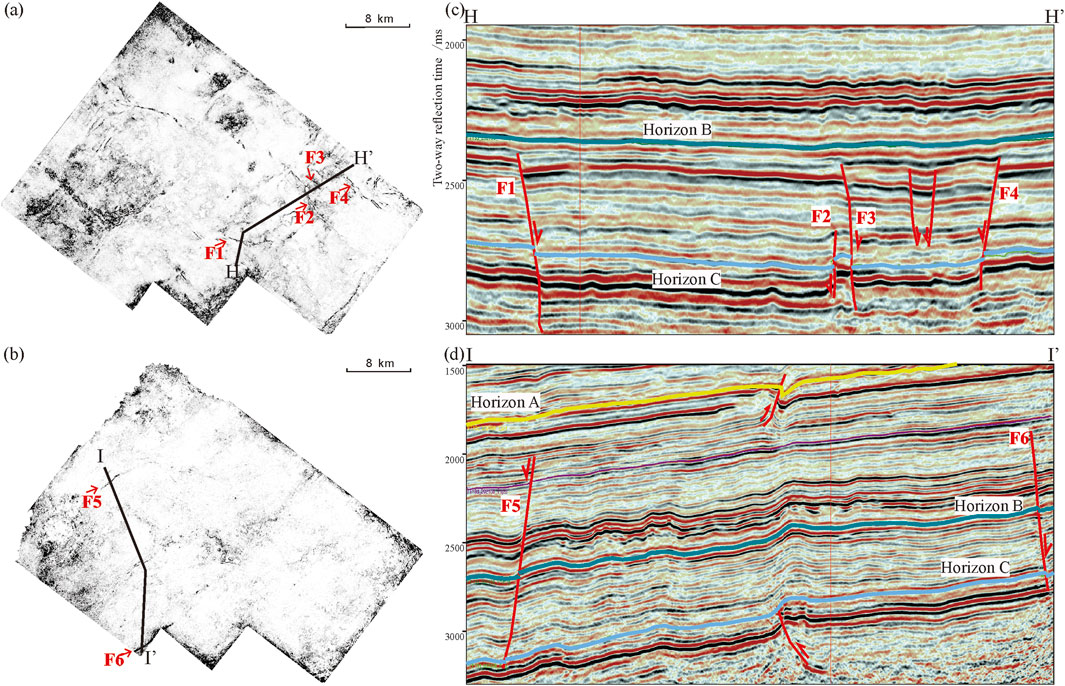
Figure 7. (a) Coherent slice of the bottom of the Cambrian Qiongzhusi Formation in the Yongtan three-dimensional seismic zone; (b) Coherent slice of the bottom of the Permian Maokou Formation in the Yongtan three-dimensional seismic zone; (c) Interpretation result of a typical Caledonian normal fault; (d) Interpretation result of a typical Indosinian normal fault. Horizon ABottom of Triassic Xujiahe Formation; Horizon BBottom of Permian Longtan Formation; Horizon CBottom of Cambrian Qiongzhusi Formation.
Example of similar faults near the foreland front uplift
We found another example of similar faults in the Jurassic strata in front of the Micangshan thrust belt. These faults have features similar to those in central Sichuan (Su et al., 2023; Su et al., 2025), including high steepness, little normal displacement, short length, even distribution, and multiple directions. According to the coherent slice at the bottom of the Jurassic Shaximiao Formation in the Longgang three-dimensional seismic zone (Figure 8a, location 2a in Figure 1), four groups of faults developed: NEE-, NW-, and NNE-striking normal faults, and a NW-striking thrust fault (Figure 8b).
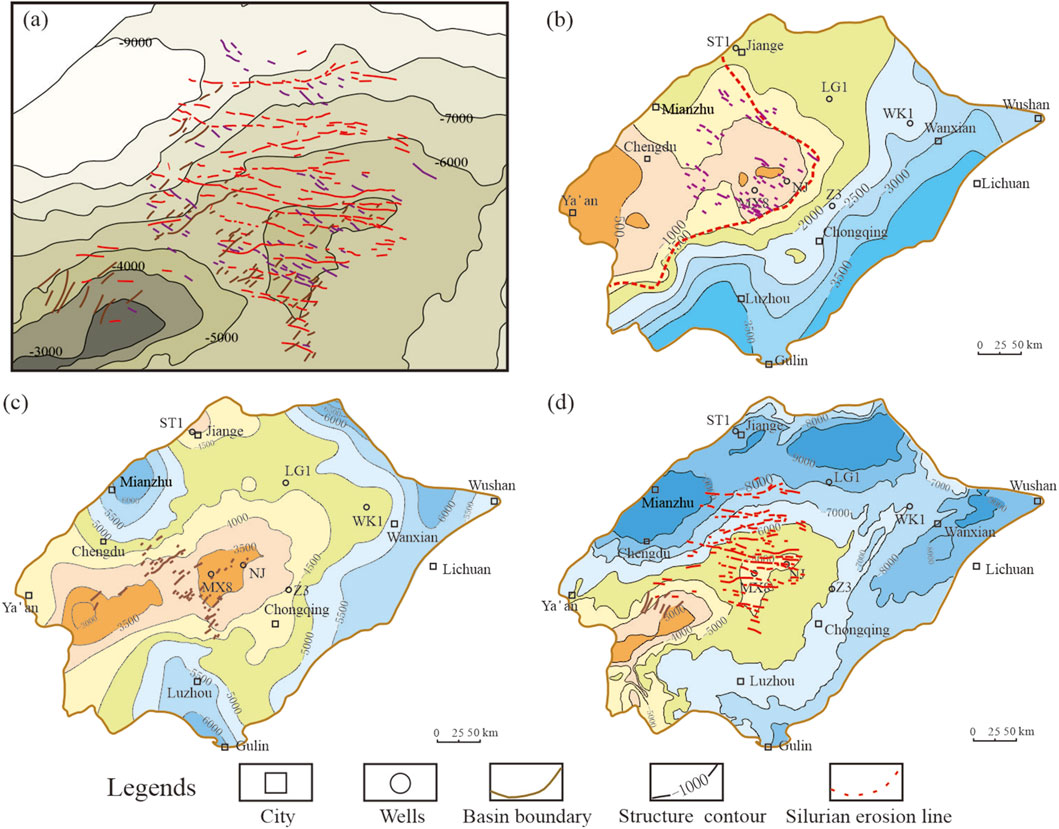
Figure 8. Cratonic strike-slip faults developed during each period related to uplift. (a) Superimposed map of multi-direction strike-slip fault and current structure of the bottom of the Cambrian in central Sichuan; (b) Paleo-tectonic map of the top of the Sinian before Permian sedimentation; (c) Paleo-tectonic map of the top of the Sinian before Jurassic sedimentation; (d) Structure map of the current Sinian top boundary.
In this case, the fault direction was also consistent with the direction of the uplift, and multistage uplifts were recorded by a combination of faults. Among these faults, NEE-striking faults were dominant and parallel to the direction of the current strata. This is a consequence of the thrust deformation of the Micangshan thrust belt during the Yanshanian–Himalayan period, which resulted in subsidence of the foreland depression, relative uplift, and strata bending within the basin. The development of the fault was more concentrated in strata with greater curvature and was slightly deflected with the change in the strata strike in the center of the work area. The NW-striking normal fault corresponds to later compression from the Dabashan thrust belt in the northeast. The NNE-striking normal fault corresponds to compression from the Longmenshan thrust belt to the west.
Genesis mechanism of uplift-related faults
The consistency of the development time and directional correlation between faults and uplifts indicates that uplifts may be the key factor for the faults in the central Sichuan area. The mechanism of these faults is the tensile strain caused by strata bending during uplift development. During this process, the outer arc strata extend, and the inner arc strata shorten and squeeze (Figure 9a). Tensile fractures or faults occur when the tension of the outer arc exceeds its tensile strength. At the fracture scale, longitudinal fractures parallel to the fold hinge typically develop in the core and wings of the fold (Engelder and Peacock, 2001; Smart et al., 2009). Although there is a scale difference between the tensile fractures and faults, this indicates the existence of tensile strain related to strata bending.

Figure 9. (a) Coherent slice of the bottom of J2s2in the Longgang three-dimensional seismic zone; (b) Fault distribution and structural map of the bottom of J2s2.
At the fault scale, some studies have found similar faults and named them bending-moment normal faults (Livio et al., 2019; Xu, 2022). In the Guman area of the West Kunlun foreland thrust belt, normal faults corresponding to the axial direction of the anticline were observed in the field at both the wings and core of the fold (Xu, 2022). The primary function of a bending-moment fault is to adjust the length or shorten strata (Burbank and Anderson, 2012). Analog experiments were used to evaluate the shape and deformation process of bending-moment normal faults during strata bending (Livio et al., 2019). In the simulation results (Figure 9b), the faults were characterized as grabens consisting of two or more high-steep normal faults with little normal displacement, similar to the faults in Figure 10. The simulation results also show that the greater curvature of strata bending is not an essential factor in fault development, that is, these faults could develop in wide and gentle uplifts or folds.

Figure 10. (a) Strain distribution during strata bending (modified after Ramsay et al., 1987; Xu, 2022); (b) Features of bending-moment normal faults in analog experiments (modified after Livio et al., 2019).
Conclusion
(1) Based on abundant seismic data analysis, cratonic strike-slip faults are not found in other parts of Sichuan basin, including the north-central Sichuan, western Sichuan foreland depression, southern Sichuan low-steep tectonic belt and eastern Sichuan high-steep tectonic belt. Cratonic strike-slip faults have a limited distribution in the central Sichuan and Weiyuan areas, indicating that these faults were controlled by the unique tectonic evolution of central Sichuan.
(2) It is proposed that these cratonic strike-slip faults are actually a combination of normal faults with different directions controlled by multi-stage uplifts inside the basin. The fault system in central Sichuan composed of three groups of faults with different directions. The three groups are respectively developed during the Caledonian period, the Indosinian period and the Yanshanian–Himalayan period, which are consistent with the development of paleo-uplifts inside the basin. And the fault directions are also parallel to the striking strata of the paleo-uplifts.
(3) Tensile strain during strata bending is the genesis mechanism of fault development. When the uplifts develop, the outer arc strata extend and normal faults occur when the tension of the outer arc exceeds its tensile strength. The central Sichuan region is characterized by superimposed multi-phase palaeo-uplift evolution, and that is the reason why the faults are concentrated here.
Data availability statement
The original contributions presented in the study are included in the article/Supplementary Material, further inquiries can be directed to the corresponding author.
Author contributions
ZL: Formal Analysis, Writing – original draft, Data curation, Writing – review and editing. NS: Conceptualization, Formal Analysis, Investigation, Methodology, Project administration, Writing – original draft, Writing – review and editing. SL: Conceptualization, Methodology, Project administration, Writing – original draft, Writing – review and editing. ZC: Writing – review and editing. PT: Data curation, Formal Analysis, Methodology, Writing – original draft, Writing – review and editing. SW: Data curation, Investigation, Writing – original draft. LW: Data curation, Formal Analysis, Writing – original draft. RR: Writing – review and editing. CH: Writing – review and editing. ZM: Writing – review and editing.
Funding
The author(s) declare that financial support was received for the research and/or publication of this article. The authors declare that this study received funding from CNPC. This research was funded by the PetroChina Science and Technology Project (Grant No. 2023ZZ0202), the National Natural Science Foundation of China (Grant No. 42430808) and Open Foundation of the Research Institute of Petroleum Exploration and Development, CNPC (No. 2024-KFKT-05). The funder was not involved in the study design, collection, analysis, interpretation of data, the writing of this article, or the decision to submit it for publication.
Conflict of interest
Authors ZL, NS, SL, ZC, PT, SW, LW, RR, and CH were employed by China National Petroleum Corporation.
The remaining author declares that the research was conducted in the absence of any commercial or financial relationships that could be construed as a potential conflict of interest.
Generative AI statement
The author(s) declare that no Generative AI was used in the creation of this manuscript.
Publisher’s note
All claims expressed in this article are solely those of the authors and do not necessarily represent those of their affiliated organizations, or those of the publisher, the editors and the reviewers. Any product that may be evaluated in this article, or claim that may be made by its manufacturer, is not guaranteed or endorsed by the publisher.
References
Bahorich, M., and Farmer, S. (1995). 3-D seismic discontinuity for faults and stratigraphic features: the coherence cube. Lead. Edge 14 (10), 1053–1058. doi:10.1190/1.1437077
Bellahsen, N., Fiore, P., and Pollard, D. (2006). The role of fractures in the structural interpretation of Sheep Mountain Anticline, Wyoming. J. Struct. Geol. 28, 850–867. doi:10.1016/j.jsg.2006.01.013
Chen, Z., Li, B., Jia, D., and Lei, Y. (2008). The cenozoic structural deformation in the northern longmenshan front belt. Acta Geol. Sin. 82 (9), 1178–1185.
Engelder, T., and Peacock, D. C. P. (2001). Joint development normal to regional compression during flexural-flow folding: the Lilstock buttress anticline, Somerset, England. J. Struct. Geol. 23, 259–277. doi:10.1016/S0191-8141(00)00095-X
Fu, X., Zhang, B., Wang, Z., Lei, M., Zhang, J., Guan, S., et al. (2023). Strike-slip faults in central and western Sichuan Basin and their control functions on hydrocarbon accumulation. Earth Sci. 48 (06), 2221–2237. doi:10.3799/dqkx.2022.478
Guan, S., Jiang, H., Lu, X., Liang, H., Zhu, G., Cui, J., et al. (2022b). Strike-slip fault system and its control on oil and gas accumulation in central Sichuan Basin. Acta Pet. Sin. 43 (11), 1542–1557. doi:10.7623/syxb202211003
Guan, S., Liang, H., Jiang, H., Fu, X., Gu, M., Lei, M., et al. (2022a). Characteristics and evolution of the main strike-slip fault belts of the central Sichuan Basin, southwestern China, and associated structures. Earth Sci. Front. 29 (06), 252–264. doi:10.13745/j.esf.sf.2022.8.8
Guan, S., Zhang, Y., Jiang, H., Lu, X., Liang, H., Huang, S., et al. (2024). Cratonic strike-slip fault systems in the central Sichuan Basin, China. Earth-Science Rev. 254 (11), 104800. doi:10.1016/j.earscirev.2024.104800
He, X., Tang, Q., Wu, G., Li, F., Tian, W., Luo, W., et al. (2023). Control of strike-slip faults on Sinian carbonate reservoirs in Anyue gas field, Sichuan Basin, SW China. Petroleum Explor. Dev. 50 (06), 1282–1294. doi:10.1016/S1876-3804(24)60466-0
Huang, L., Liu, C., He, F., Jia, H., Zhou, Y., Wang, Z., et al. (2022). Strike-slip deformation characteristics of fault in craton basin. J. Northwest Univ. Nat. Sci. Ed. 52 (6), 930–942. doi:10.16152/j.cnki.xdxbzr.2022-06-003
Huang, L., Liu, C., Wang, Z., Zhou, Y., He, F., Liu, Y., et al. (2025). An alternative formation mechanism for strike-slip fault in stable intracratonic basin. J. Struct. Geol. 191, 105292. doi:10.1016/j.jsg.2024.105292
Ismat, Z. (2008). Folding kinematics expressed in fracture patterns: an example from the Anti-Atlas fold belt, Morocco. J. Struct. Geol. 30, 1396–1404. doi:10.1016/j.jsg.2008.07.010
Jia, D., Chen, Z., Jia, C., Wei, G., Li, B., Zhang, Q., et al. (2003). Structural features of the longmen Shan fold and thrust belt and development of the western sichuan foreland basin, Central China. Geol. J. China Univ. 9 (3), 402–410.
Jiao, F., Yang, Y., Ran, Q., Wu, G., and Liang, H. (2022). Distribution and gas exploration of the strike-slip faults in the central Sichuan Basin. Nat. Gas. Ind. B 41 (08), 63–72. doi:10.1016/j.ngib.2021.08.018
Li, C., Chen, H., Tang, D., Wang, Z., and Jiang, H. (2023a). Strike-slip faults controlled “floor type” hydrocarbon accumulation model in gaoshiti-moxi area, Sichuan Basin: a case study of sinian-cambrian. Earth Sci. 48 (06), 2254–2266. doi:10.3799/dqkx.2023.018
Li, H., Tang, H., Qin, Q., Zhou, J., Qin, Z., Fan, C., et al. (2019). Characteristics, formation periods and genetic mechanisms of tectonic fractures in the tight gas sandstones reservoir: a case study of Xujiahe Formation in YB area, Sichuan Basin, China. J. Petroleum Sci. Eng. 178, 723–735. doi:10.1016/j.petrol.2019.04.007
Li, J., Li, H., Xu, J., Wu, Y., and Gao, Z. (2022). Effects of fracture formation stage on shale gas preservation conditions and enrichment in complex structural areas in the southern Sichuan Basin, China. Front. Earth Sci. 10, 921988. doi:10.3389/feart.2022.921988
Li, J., Li, H., Yang, C., Ren, X., and Li, Y. (2023b). Geological characteristics of deep shale gas and their effects on shale fracability in the Wufeng–Longmaxi Formations of the southern Sichuan Basin, China. Lithosphere 2023 (1), 4936993. doi:10.2113/2023/4936993
Li, W., Wang, J., Li, J., Liu, X., Cheng, K., and He, Q. (2018). Characteristics and origin of the Sinian-Permian fault system and its controls on the formation of paleo-carbonate reservoirs:A case study from Central Paleo-Uplift, Sichuan Basin, China. Interpretation 6 (1), 191–208. doi:10.1190/INT-2016-0228.1
Li, Z., Zhang, Z., Li, S., and Xia, W. (2024). Characteristics of fault systems and their reservoir control in the Qijiang area of Southeast Sichuan Basin. Nat. Gas. Geosci. 35 (11), 1999–2011. doi:10.11764/j.issn.1672-1926.2024.04.007
Liang, H., Tang, H., Ran, Q., Chen, K., Ma, B., Huang, T., et al. (2023). The distribution, type and origin of strike-slip faults in the Sichuan basin. Acta Geol. Sin. 97 (08), 2609–2620. doi:10.19762/j.cnki.dizhixuebao.2023138
Liu, S., Deng, B., Li, Z., Sun, W., Wu, J., Luo, C., et al. (2024). The qiongzhusi-dengying petroleum system in the Sichuan Basin, China. AAPG Bull. 108 (4), 663–689. doi:10.1306/12052321155
Liu, S., Yang, Y., Deng, B., Zhong, Y., Wen, L., Sun, W., et al. (2021). Tectonic evolution of the Sichuan Basin, southwest China. Earth-Science Rev. 213, 103470. doi:10.1016/j.earscirev.2020.103470
Livio, F., Kettermann, M., Reicherter, K., and Urai, J. L. (2019). Growth of bending-moment faults due to progressive folding: insights from sandbox models and paleoseismological implications. Geomorphology 326, 152–166. doi:10.1016/j.geomorph.2018.02.012
Lu, X., Gui, L., Wang, Z., Liu, S., Liu, Q., Fan, J., et al. (2024). Activity time of strike-slip faults and their controlling effects on hydrocarbon accumulation in central Sichuan Basin: evidence from U-Pb dating and fluid inclusions of cements in fault zone. Acta Pet. Sin. 45 (4), 642–658. doi:10.7623/syxb202404003
Ma, B., Liang, H., Wu, G., Tang, Q., Tian, W., Zhang, C., et al. (2023). Formation and evolution of the strike-slip faults in the central Sichuan Basin, SW China. Petroleum Explor. Dev., 50(02):373–387. doi:10.1016/S1876-3804(23)60394-5
Ma, D., Wang, Z., Duan, S., Gao, J., Jiang, Q., Jiang, H., et al. (2018). Strike-slip faults and their significance for hydrocarbon accumulation in Gaoshiti-Moxi area, Sichuan Basin, SW China. Petroleum Explor. Dev. 45 (5), 851–861. doi:10.1016/S1876-3804(18)30088-0
Mclennan, J. A., Allwardt, P. F., Hennings, P. H., and Farrell, H. E. (2009). Multivariate fracture intensity prediction: application to Oil Mountain anticline, Wyoming. AAPG Bull. 93 (11), 1585–1595. doi:10.1306/07220909081
Mei, L., Liu, Q., Yang, J., Shen, C., and Fan, Y. (2010). Mesozoic intra-continental progressive deformation in western hunan-hubei-eastern sichuan provinces of China: evidence from apatite fission track and balanced cross-section. Earth Sci. 35 (2), 161–174. doi:10.3799/dqkx.2010.017
Ramsay, J. G., and Huber, M. I. (1987). “Folds and fractures,” in The techniques of modern structural geology. London: Academic Press, 381. doi:10.1016/0191-8141(88)90041-7
Smart, K. J., Ferrill, D. A., and Morris, A. P. (2009). Impact of interlayer slip on fracture prediction from geomechanical models of fault-related folds. AAPG Bull. 93 (11), 1447–1458. doi:10.1306/05110909034
Su, N., Chen, Z., Yang, W., Wang, L., Li, W., Yang, C., et al. (2023). Features of normal faults in Jurassic strata in northern central Sichuan Basin and favorable exploration direction. J. Nat. Gas Geoscience 34 (9), 1581–1594. doi:10.1016/j.jnggs.2023.11.003
Su, N., Chen, Z., Zhai, Y., Pan, Y., Wang, L., Ren, R., et al. (2025). Genetic mechanisms of normal faults in the superimposed structural zone in the foreland area of the northern Sichuan Basin. Oil and Gas Geology 46 (2), 478–490. doi:10.11743/ogg20250210
Su, N., Yang, W., Yuan, B., Dai, X., Wang, X., Wu, S., et al. (2021). Structural features and deformation mechanism of transtensional faults in Himalayan period, Sichuan Basin. Earth Sci. 46 (7), 2362–2378. doi:10.3799/dqkx.2020.202
Su, N., Zou, L., Shen, X., Guo, F., Ren, Y., Xie, Y., et al. (2014a). Fracture patterns in successive folding in the western Sichuan basin, China. J. Asian Earth Sci. 81, 65–76. doi:10.1016/j.jseaes.2013.12.003
Su, N., Zou, L., Shen, X., Zhang, G., Kong, F., Zhang, Z., et al. (2014b). Identification of fracture development period and stress field analysis based on fracture fabrics in tectonic superposition areas. Arabian J. Geosciences 7, 3983–3994. doi:10.1007/s12517-013-1063-6
Tang, D., Chen, H., Geng, F., Qi, R., Jiang, H., and Guzailinuer, A. (2023). Characteristics of intraplate small-displacement strike-slip faults: a case study of tarim, sichuan and ordos basins. Earth Sci. 48 (6), 2067–2086. doi:10.3799/dqkx.2023.037
Tian, F., Guo, T., He, D., Gu, Z., Meng, X., Wang, R., et al. (2024a). Three-dimensional structural models, evolution and petroleum geological significances of transtensional faults in the Ziyang area, central Sichuan Basin, SW China. Petroleum Explor. Dev. 51 (3), 604–620. doi:10.1016/s1876-3804(24)60491-x
Tian, F., Liang, H., Zang, D., Liu, H., Wu, F., He, D., et al. (2024b). Structural characteristics of strike-slip faults in the Luzhou-Yunjin area, southern Sichuan Basin. Chin. J. Geol. 59 (3), 804–818. doi:10.12017/dzkx.2024.058
Tingdahl, K. M., and Rooij, M. D. (2005). Semi-automatic detection of faults in 3D seismic data. Geophys. Prospect. 53 (4), 533–542. doi:10.1111/j.1365-2478.2005.00489.x
Wang, X., Wo, Y., Zhou, Y., Zhang, R., and Li, S. (2010). The kinematics of the fold-thrust zones in the western Yangtze Area. Earth Sci. Front. 17 (03), 200–212.
Wang, Z., Zhao, W., Xu, A., Li, D., and Cui, Y. (2006). Structure styles and their deformation mechanisms of dabashan foreland thrust belt in the north of Sichuan Basin. Geoscience 3, 429–435.
Wu, G., Zou, Y., Xu, W., Zhou, G., Zhong, Y., Yan, W., et al. (2023a). Distribution and petroleum exploration significance of Sinian strike-slip faults in the northern slope of Central Sichuan paleouplift. Nat. Gas. Ind. 43 (07), 35–43. doi:10.3787/j.issn.1000-0976.2023.07.004
Wu, X. (2017). Directional structure-tensor-based coherence to detect seismic faults and channels. Geophysics 82 (2), A13–A17. doi:10.1190/geo2016-0473.1
Wu, Y., Liu, J., Feng, L., Pang, Y., Tang, Q., Liu, X., et al. (2023b). Characteristics of the strike-slip faults and their effects on the gas accumulation in the southeastern Kaijiang-Liangping trough,Sichuan Basin. Mar. Orig. Pet. Geol. 28 (3), 291–300.
Xiao, A., Wei, G., Shen, Z., Wang, L., Yang, W., and Qian, J. (2011). Basin-mountain system and tectonic coupling between Yangtze block and South Qinling orogen. Acta Petrol. Sin. 27 (3), 601–611.
Xu, J. (2022). Guman Fault-Bending folding and bending-moment normal faulting and related strong earthquake in the western Kunlun foreland basin. Beijing: Institute of Geology, China Earthquake Administration. doi:10.27489/d.cnki.gzdds.2022.000034
Yan, D., Zhou, M., Li, S., and Wei, G. (2011). Structural and geochronological constraints on the Mesozoic-Cenozoic tectonic evolution of the Longmen Shan thrust belt, eastern Tibetan Plateau. Tectonics 30, TC6005. doi:10.1029/2011TC002867
Yin, J., Gu, Z., and Li, Q. (2013). Characteristics of deep-rooted faults and their geological significances in Dachuanzhong area,Sichuan Basin. Oil and Gas Geol. 34 (3), 376–382. doi:10.11743/ogg20130314
Yong, L., Allen, P. A., Densmore, A. L., and Qiang, X. (2003). Evolution of the longmen Shan foreland basin (western sichuan, China) during the late triassic indosinian orogeny. Basin Res. 15, 117–138. doi:10.1046/j.1365-2117.2003.00197.x
Zhang, X., Ran, Q., Chen, K., Zhang, B., Zhang, C., Ma, B., et al. (2022). The controlling effect of strike-slip fault on Dengying Formation reservoir and gas enrichment in Anyue Gas Field in central Sichuan Basin. Nat. Gas. Geosci. 33 (06), 917–928. doi:10.11764/j.issn.1672-1926.2021.11.009
Zhang, Y., Dong, S., Li, J., Cui, J., Shi, W., Su, J., et al. (2012). The new progress in the study of Mesozoic tectonics of South China. Acta Geosci. Sin. 33 (03), 257–279. doi:10.3975/cagsb.2012.03.01
Zhang, Z. (2009). Superposed buckle folding in the northwest Dabashan, central China. Acta Geol. Sin. 83 (07), 923–936.
Keywords: Sichuan basin, cratonic strike-slip faults, genesis mechanism, tensile strain, middle-late triassic, jurassic-cretaceous
Citation: Liu Z, Su N, Liu S, Chen Z, Tang P, Wu S, Wang L, Ren R, Hao C and Miao Z (2025) Limited distribution of cratonic strike-slip faults in Sichuan basin and their genesis mechanisms. Front. Earth Sci. 13:1556272. doi: 10.3389/feart.2025.1556272
Received: 06 January 2025; Accepted: 28 April 2025;
Published: 14 May 2025.
Edited by:
Fan Yang, Lanzhou University, ChinaReviewed by:
Hu Li, Sichuan University of Science and Engineering, ChinaMarco Tallini, L’Aquila University, Italy
Copyright © 2025 Liu, Su, Liu, Chen, Tang, Wu, Wang, Ren, Hao and Miao. This is an open-access article distributed under the terms of the Creative Commons Attribution License (CC BY). The use, distribution or reproduction in other forums is permitted, provided the original author(s) and the copyright owner(s) are credited and that the original publication in this journal is cited, in accordance with accepted academic practice. No use, distribution or reproduction is permitted which does not comply with these terms.
*Correspondence: Nan Su, c3VuYW4xMWEyM0BwZXRyb2NoaW5hLmNvbS5jbg==
 Zijing Liu1,2
Zijing Liu1,2 Nan Su
Nan Su Zhengshuo Miao
Zhengshuo Miao